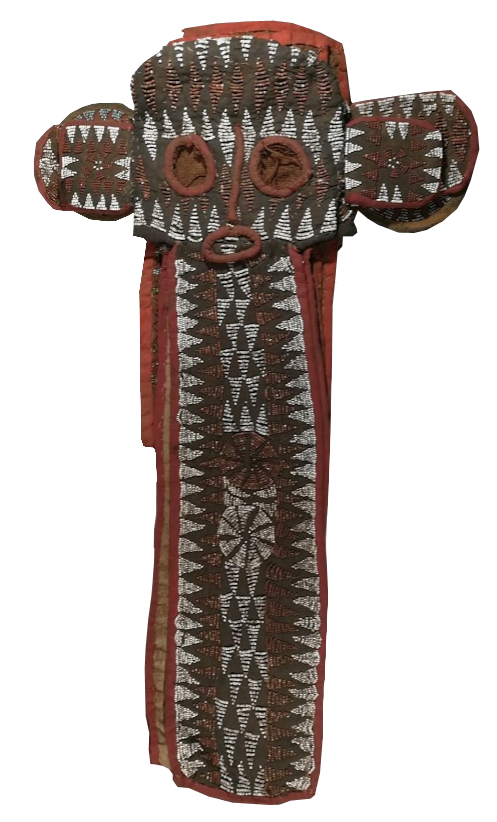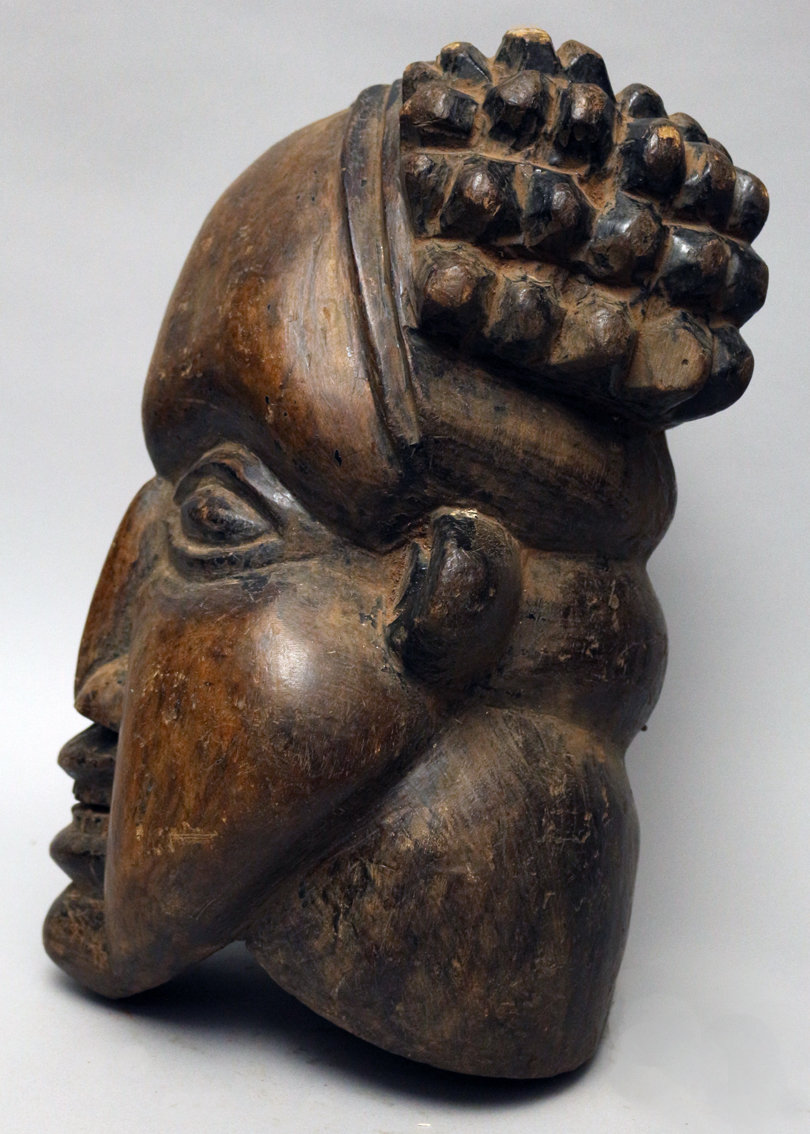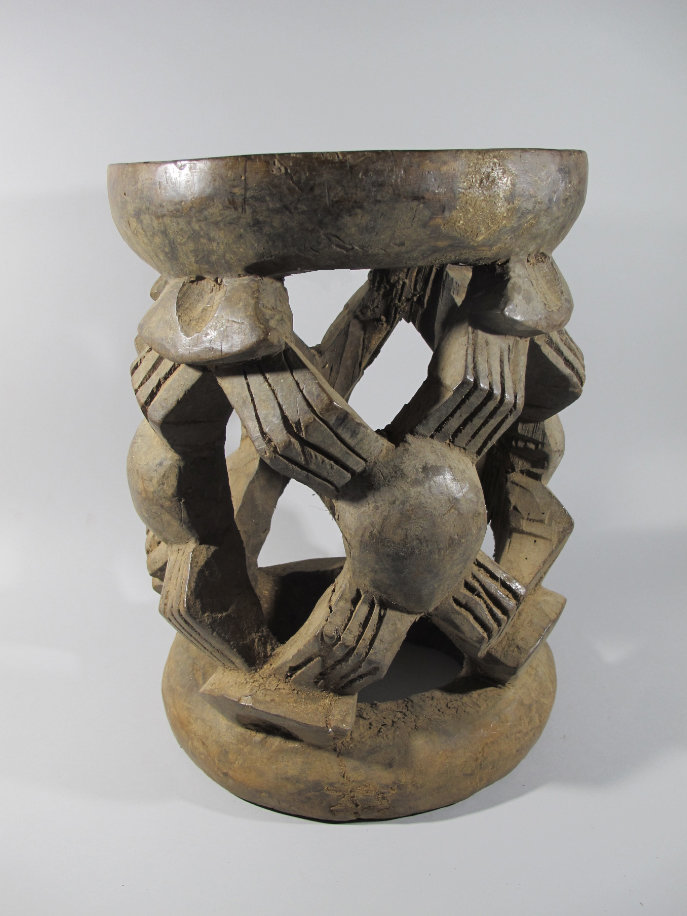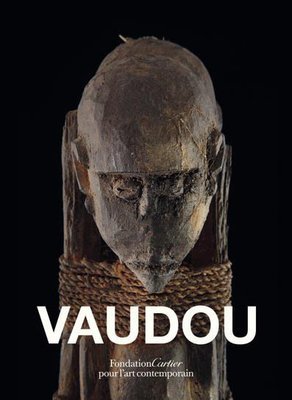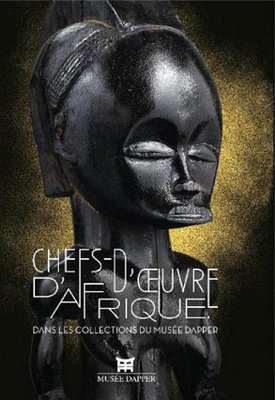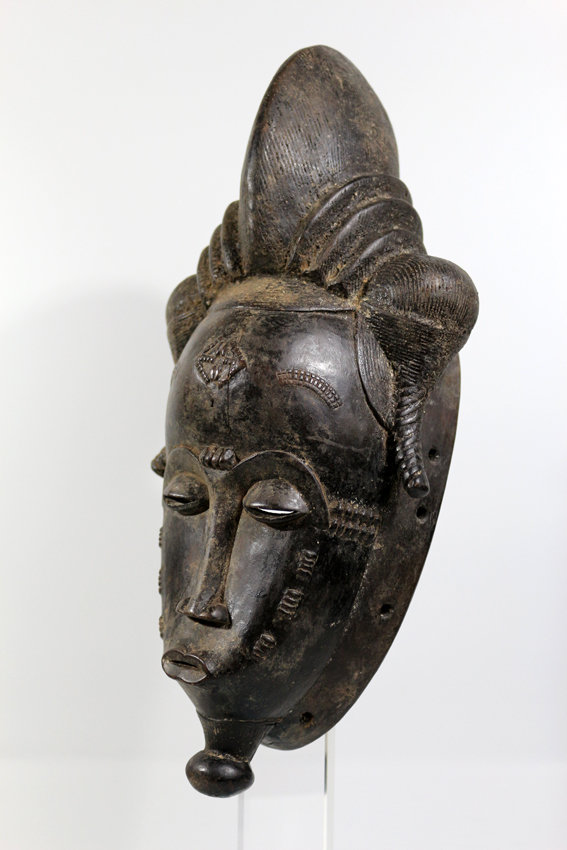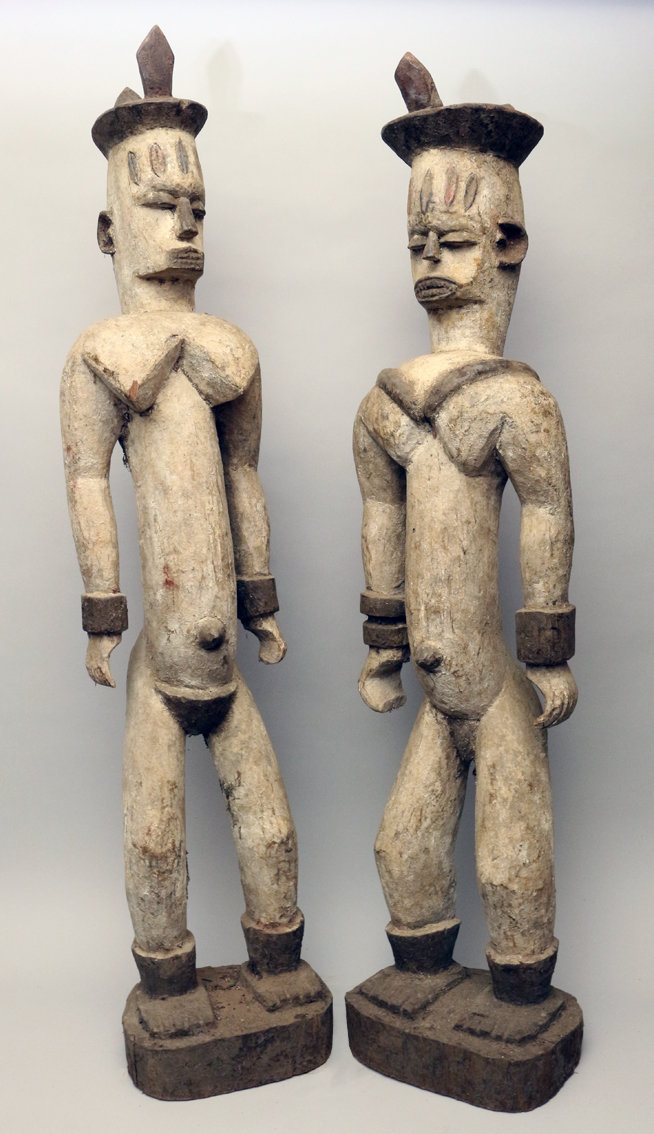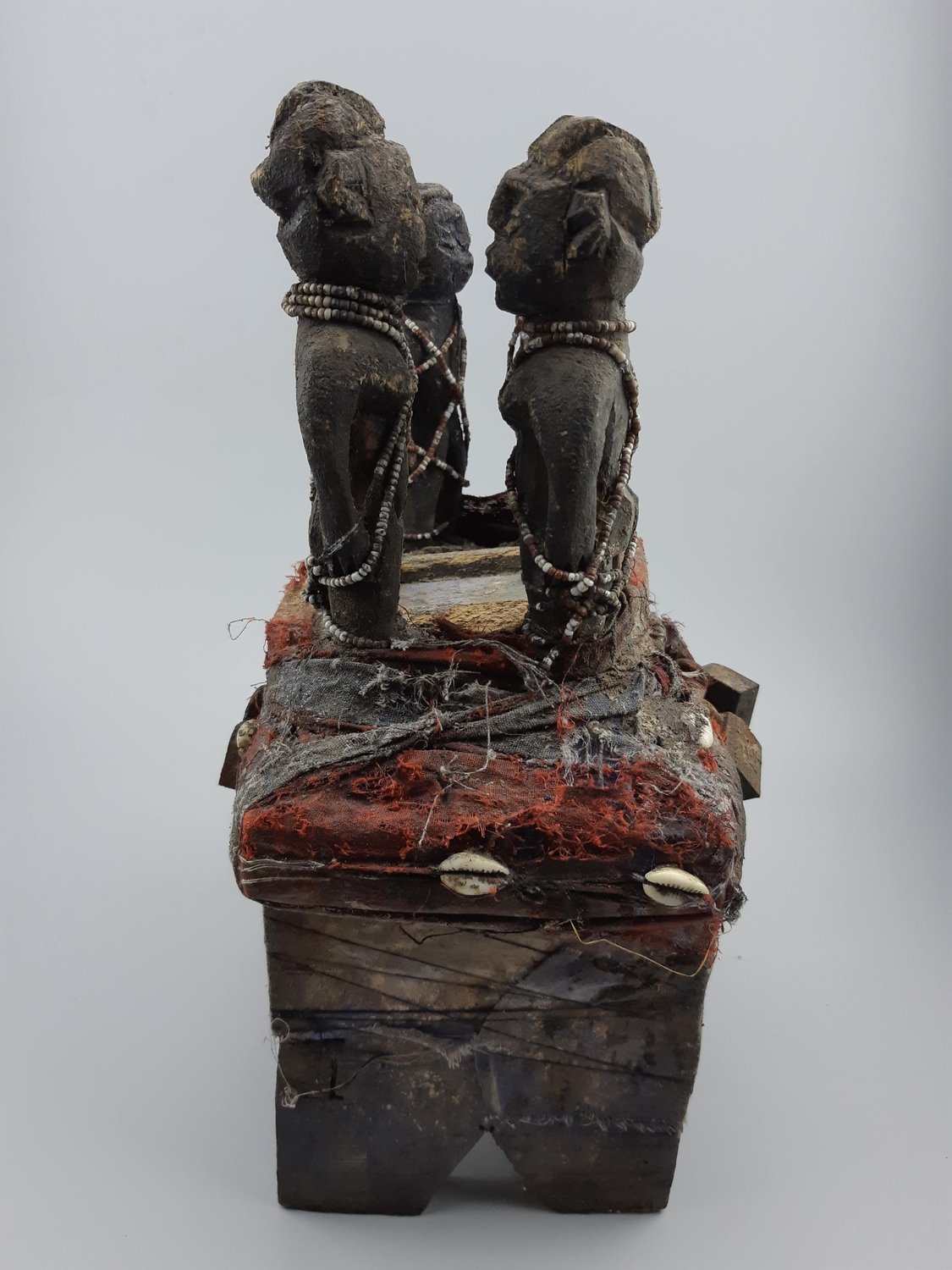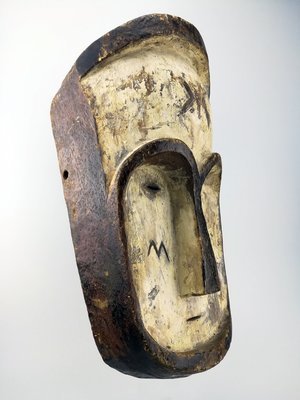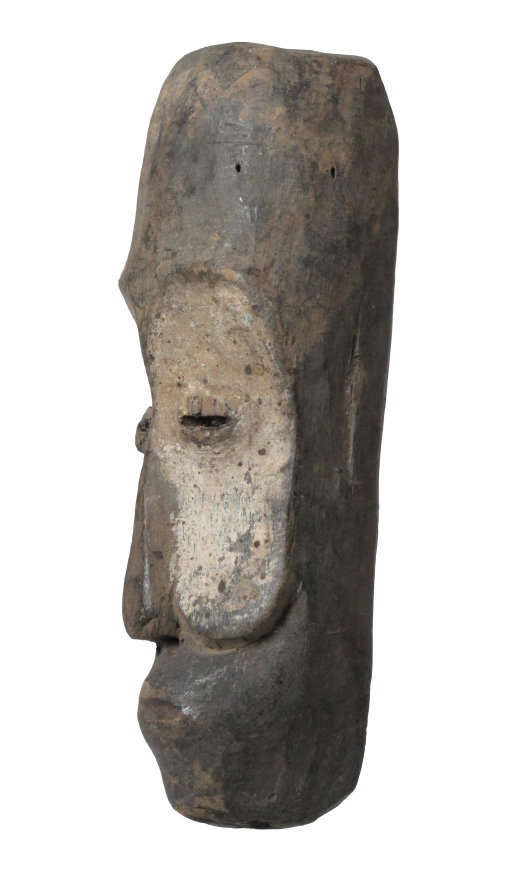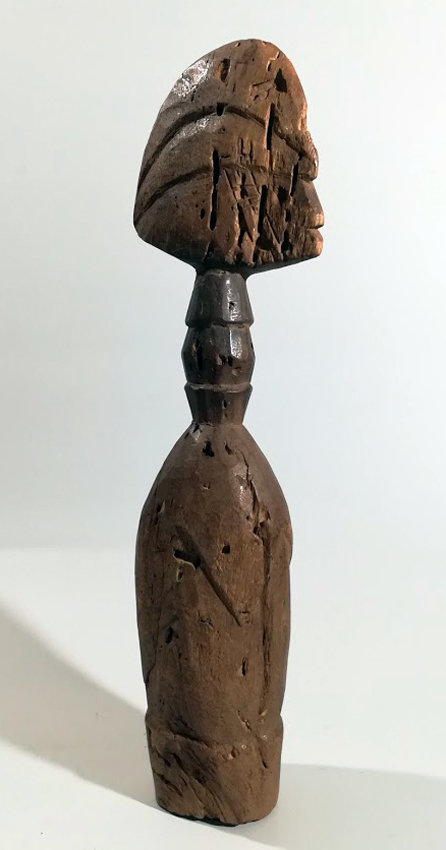-
Quick View€2,100.00
The Bamileke are a people of Central Africa, coming from Cameroon (West region) in the Grassland region where the Bamoun, Tikar also live, close to them by their common ancestors, their neighboring social structures and their languages. .
The work of D. Toukam (“History and anthropology of the Bamileke people”, Paris, L’Harmattan, 2010 and 2016; …) conclude that the Bamileke would most likely come from the Baladis of ancient Egypt (natives of Upper -Egypt). In Egypt, the current Feelahins / Copts are largely recognized as Baladis converted by force, but still retaining huge parts of their ancestral culture. Departing from Upper Egypt in the 9th century AD, the Baladis-Bamileke arrived in the Tikar region in the 12th century. They were neighbors of the Tikar, but were never descendants of Tikar, contrary to popular belief.
The Bamilekes are, in spiritual matters, of great complexity The whole of their traditional religious organization is composed of initiation practices, meditations and rituals.
Their production of objects linked to their different cults has been very rich and some cults are still in progress today by exploiting ancient masks kept in certain chiefdoms or with certain notables or pieces called ” replacement “created to replace old worn, too damaged parts or because the use was limited in time.
-
Quick View€3,200.00
Cameroon, Bamiléké – Dance mask
The Bamileke are a people of Central Africa, coming from Cameroon (West region) in the Grassland region where the Bamoun, Tikar also live, close to them by their common ancestors, their neighboring social structures and their languages. .
The work of D. Toukam (“History and anthropology of the Bamileke people”, Paris, L’Harmattan, 2010 and 2016; …) conclude that the Bamileke would most likely come from the Baladis of ancient Egypt (natives of Upper -Egypt). In Egypt, the current Feelahins / Copts are largely recognized as Baladis converted by force, but still retaining huge parts of their ancestral culture. Departing from Upper Egypt in the 9th century AD, the Baladis-Bamileke arrived in the Tikar region in the 12th century. They were neighbors of the Tikar, but were never descendants of Tikar, contrary to popular belief.
The Bamilekes are, in spiritual matters, of great complexity The whole of their traditional religious organization is composed of initiation practices, meditations and rituals.
Their production of objects linked to their different cults has been very rich and some cults are still in progress today by exploiting ancient masks kept in certain chiefdoms or with certain notables or pieces called ” replacement “created to replace old worn, too damaged parts or because the use was limited in time.
-
Quick View€4,200.00
The Bamileke are a people of Central Africa, coming from Cameroon (West region) in the Grassland region where the Bamoun, Tikar also live, close to them by their common ancestors, their neighboring social structures and their languages. .
The work of D. Toukam (“History and anthropology of the Bamileke people”, Paris, L’Harmattan, 2010 and 2016; …) conclude that the Bamileke would most likely come from the Baladis of ancient Egypt (natives of Upper -Egypt). In Egypt, the current Feelahins / Copts are largely recognized as Baladis converted by force, but still retaining huge parts of their ancestral culture. Departing from Upper Egypt in the 9th century AD, the Baladis-Bamileke arrived in the Tikar region in the 12th century. They were neighbors of the Tikar, but were never descendants of Tikar, contrary to popular belief.
The Bamilekes are, in spiritual matters, of great complexity The whole of their traditional religious organization is composed of initiation practices, meditations and rituals.
Their production of objects linked to their different cults has been very rich and some cults are still in progress today by exploiting ancient masks kept in certain chiefdoms or with certain notables or pieces called ” replacement “created to replace old worn, too damaged parts or because the use was limited in time.
-
Quick View
Exhibition catalog “Voodoo” presented at the Cartier Foundation for Contemporary Art, Paris (April 5 – September 25, 2011).
Designed as an extension of the exhibition, the Vaudou catalog brings together more than 150 photographs taken by Yuji Ono as part of a specific order. The book also returns to the atypical journey of Jacques Kerchache and his passion for African statuary through numerous documents and personal photographs.
Le catalogue reprend les textes de Jacques Kerchache sur l’art africain et sur le vaudou du Bénin, dont certains étaient jusqu’à présent restés inédits. Les contributions de spécialistes comme Suzanne Preston-Blier, Gabin Djimassé ou encore de l’artiste Patrick Vilaire donnent également un nouvel éclairage sur le vaudou africain, et font de ce catalogue un ouvrage de référence sur le sujet.
Grand esthète, spécialiste des arts primitifs, Jacques Kerchache a offert ses lettres de noblesse aux arts premiers en leur ouvrant les portes des plus grands musées français. L’exposition Vaudou est l’occasion pour la Fondation Cartier de réaliser le souhait de ce grand connaisseur de l’art africain pour qui le vaudou représentait une réelle fascination.
L’exposition présente une centaine de statuettes, pour la plupart anthropomorphes, résultant d’un assemblage mystérieux d’ossements, de cordes, de coquillages et de tissus, souvent recouverts de terre, d’huile de palme ou de sang. Ayant pour beaucoup d’entre eux été utilisés dans le cadre de rites vaudou, ces objets en tirent un caractère effrayant qui s’ajoute à l’étrangeté de leurs caractéristiques formelles.
La scénographie de l’exposition, réalisée par Enzo Mari, l’un des grands maîtres du design italien, explorera l’étrange beauté de ces oeuvres au pouvoir unique.
Editions Fondation Cartier – Ouvrage relié – 250 pages – Textes en Français/Anglais- Publié en 12/04/2011L’exposition Vaudou dévoile pour la première fois au public un ensemble exceptionnel d’oeuvres vaudou du Bénin et du Togo provenant de la collection d’Anne et Jacques Kerchache.
Présentation de l’exposition :
La Fondation Cartier pour l’art contemporain présente un ensemble exceptionnel d’objets vaudou africains issus de la collection Anne et Jacques Kerchache, à travers une scénographie conçue par Enzo Mari, l’un des grands maîtres du design italien.
Avec près d’une centaine de bocio dont certains appartiennent désormais à d’autres collections privées, Vaudou est la première grande exposition consacrée exclusivement à ces sculptures traditionnelles d’Afrique occidentale.
Le vaudou d’Afrique est un culte religieux ancien et une tradition philosophique originaire d’Afrique occidentale. Aujourd’hui, il est encore pratiqué de la côte du Togo à l’Ouest du Nigeria. Avec la traite des esclaves, aux XVIIe et XVIIIe siècles, ce culte s’est propagé jusqu’aux Caraïbes ainsi qu’en Amérique du Nord et du Sud où il s’est mêlé
au catholicisme et à d’autres traditions religieuses.Les adeptes du vaudou pensent qu’il y a un lien entre le monde visible des vivants et celui, invisible, des esprits, et que ces mondes peuvent communiquer par le sacrifice, la prière, la possession et la divination.
Les sculptures bocio sont reliées à l’énergie des divinités vaudou. Dans ce culte, elles sont les intermédiaires entre le monde visible et le monde spirituel.
Assemblages d’éléments hétéroclites au cordes, ossements,
coquillages et mèches de cheveux au recouverts d’une épaisse couche de matière pouvant être faite d’argile, d’huile de palme et de matériaux sacrificiels, ces statues étranges et mystérieuses dégagent un
sentiment de tension et d’appréhension.Explorateur et expert autodidacte, Jacques Kerchache (1942-2001) est célèbre pour sa connaissance des arts premiers qu’il a développée à travers ses nombreux voyages en Afrique, Amérique centrale et Amérique du Sud.
La scénographie d’Enzo Mari permet à ces oeuvres impénétrables de prendre la parole dans une présentation fondée sur une simplicité empreinte de sobriété et d’élégance.
The exhibition also brings together the notes, letters and photographs of Jacques Kerchache in connection with his expeditions, his research on voodoo and his projects for the exhibition of primary arts in French museums.
The archival films of his travels allow us to explore voodoo in its context and to take a new look at an art that reflects the universal and eternal concerns of humanity.
-
Quick View
Chefs-d’oeuvres d’Afrique dans les collections du musée Dapper
Des pièces majeures, qui pour certaines d’entre elles n’ont pas d’équivalent dans le monde, sont réunies pour la première fois dans un ouvrage de référence publié en hommage à Michel Leveau, le fondateur du musée Dapper.
Nombre de ces objets ont appartenu auparavant à des grands noms ayant marqué la reconnaissance des arts non occidentaux au début du XXe siècle – Paul Guillaume, Jacob Epstein, Charles Ratton…
Remarquables par leur qualité esthétique, les quelque cent trente œuvres reproduites – masques, statues, statuettes, insignes et parures – témoignent de la richesse des pratiques artistiques de l’Afrique subsaharienne. Leurs fonctions politiques, sociales et religieuses sont éclairées par les analyses de spécialistes reconnus, anthropologues, ethnolinguistes ou historiens de l’art.Chaque auteur a rédigé pour ce catalogue, qui s’articule en deux grandes sections – Afrique centrale et Afrique de l’Ouest –, un texte de présentation général suivi de notices dans lesquelles il a résumé l’essentiel de ses connaissances sur le sujet.
Ce livre permettra à chaque lecteur, spécialiste, simple amateur ou néophyte, d’entreprendre un voyage riche de découvertes à travers l’univers des formes et des spiritualités que les cultures africaines nous proposent en partage.
AUTEURS
Alain-Michel Boyer, Jean-Paul Colleyn, Christiane Falgayrettes-Leveau, Michel Leveau, Christiane Owusu-Sarpong, Anne van Cutsem-Vanderstraete, Jean-Pierre Warnier
Collectif sous la direction de Christiane Falgayrettes-Leveau
Éditions Dapper, 2015
Format : 22 x 29 cm – 320 pages
-
Quick View€1,600.00
Ivory Coast, Baoulé mask
The Baoulés (Ba Ou li) are a people of Côte d’Ivoire, living mainly in the center of the country, near the cities of Bouaké and Yamoussoukro. They represent around 23% of the country’s population (around 3,943,667 individuals), which makes the Baoulés the first ethnic group in the country, ahead of the Betes and the Senoufos, who constitute the country’s second and third ethnic groups respectively. The Baoulés are part of the Akan group and are from neighboring Ghana. They settled in Ivory Coast in the 18th century, guided by Queen Abla Pokou. The name Baoulé comes from the sacrifice, by Queen Pokou, of one of her sons in order to cross a river, while she was leading the flight of her people from Ghana: ba ou li (the child is dead). The Baoulés settled between the Bandama and Comoé rivers.
***
Ivory Coast, Baule Mask
The Baoulés (Ba Ou li) are a people of Ivory Coast, living mainly in the center of the country, near the cities of Bouaké and Yamoussoukro. They represent about 23% of the population of the country (about 3,943,667 individuals) which makes Baoulés the first ethnic group of the country ahead of Betes and Senoufos which respectively constitute the second and third ethnic group of the country. The Baoulés are part of the Akan group and come from neighboring Ghana. They settled in Ivory Coast in the eighteenth century, guided by Queen Abla Pokou. The name Baoulé comes from the sacrifice, by queen Pokou, of one of her sons to cross a river, while she led the flight of her people from Ghana: ba or li (the child is dead). The Baoulés settled between the rivers Bandama and Comoé.
***
Elfenbeinküste, Baule-Maske
Die Baoulés (Ba Ou li) sind ein Volk der Elfenbeinküste, die hauptsächlich in der Mitte des Landes leben, in der Nähe der Städte Bouaké und Yamoussoukro. Sie repräsentieren etwa 23% der Bevölkerung des Landes (etwa 3 943 667 Personen), was Baoulés zur ersten ethnischen Gruppe des Landes vor Bêtes und Senoufos macht, die die zweite bzw. dritte ethnische Gruppe des Landes bilden. Die Baoulés gehören zur Akan-Gruppe und kommen aus dem benachbarten Ghana. Sie ließen sich im 18. Jahrhundert in der Elfenbeinküste unter der Führung von Königin Abla Pokou nieder. Der Name Baoulé kommt von der Opferung eines ihrer Söhne durch Königin Pokou, um einen Fluss zu überqueren, während sie die Flucht ihrer Leute aus Ghana führte: ba oder li (das Kind ist tot). Die Baoulés ließen sich zwischen den Flüssen Bandama und Comoé nieder.
-
Quick View€2,500.00
-
Quick View
Objets du Culte Vaudou, Bénin
Table de divination.
Le vaudou (ou vodou, ou vodoun), plus rarement appelé vaudouisme, est une religion originaire de l’ancien royaume du Dahomey (Afrique de l’Ouest). Parfois assimilé à des pratiques occultes éclatées en de multiples communautés, cette religion d’ordre cosmique issue des cultes animistes africains, est toujours largement répandue au Bénin et au Togo, comme dans le célèbre marché des féticheurs à Lomé.
À partir du xviie siècle, les Noirs capturés, réduits en esclavage, originaires de cette région d’Afrique répandirent le culte vaudou aux Caraïbes et en Amérique. Le vaudou se retrouve donc sous différentes formes à Cuba, en Haïti, au Brésil ou encore aux États-Unis, en Louisiane surtout. Il s’est aussi répandu en Afrique du Nord, où il se retrouve sous différentes formes, dont la plus connue est le Gnawa au Maroc mélangé au folklore religieux arabo-musulman. Le culte vaudou compte environ 50 millions de pratiquants dans le monde. De nombreuses communautés « vaudouisantes » existent dans le monde entier, majoritairement sur le continent américain, et aux Antilles. Il existe en Europe des communautés plus discrètes mais néanmoins actives tel que le Hounfor bonzanfè, le Lakou sans Lune ou le Hounfor Konblanmen. Au début du xxie siècle, le vaudou s’étend également au Canada où de nombreuses communautés ont vu le jour et tentent de mettre ce système de croyance au devant de la scène.
Malgré cette diffusion internationale c’est encore sur sa terre d’origine l’Afrique que le Vaudou a continué à produire des objets d’art exceptionnels en support à ses divers rituels.
Il existe un musée du vaudou à Essen en Allemagne (le Soul of Africa Museum (de)) et à Strasbourg en France (le château Vodou). De grandes expositions internationales lui sont régulièrement consacrées et sa présentation sur les plus grands salons d’art internationaux devient de plus en plus fréquente.
***
Objects of the Voodoo Cult, Benin
Divination table.
Voodoo (or voodoo, or voodoo), more rarely called voodooism, is a religion originating in the ancient kingdom of Dahomey (West Africa). Sometimes assimilated to occult practices exploded in multiple communities, this religion of cosmic order resulting from African animist cults, is still widespread in Benin and Togo, as in the famous fetish market in Lome.
From the seventeenth century, blacks captured in enslavement from this region of Africa spread voodoo worship in the Caribbean and America. Voodoo is therefore found in different forms in Cuba, Haiti, Brazil or the United States, especially in Louisiana. It has also spread to North Africa, where it is found in various forms, the best known is the Gnawa in Morocco mixed with religious Arab-Muslim folklore. Voodoo worship has about 50 million practitioners around the world. Many “voodoo” communities exist throughout the world, mostly in the Americas, and in the West Indies. In Europe there are more discreet but active communities such as Hounfor Bonzanfe, Lakou without Moon or Hounfor Konblanmen. At the beginning of the twenty-first century, voodoo also spreads to Canada where many communities have emerged and are trying to put this belief system in the spotlight.
In spite of this international diffusion, Voodoo has continued to produce exceptional objects of art in support of its various rituals on its native land of Africa.
There is a voodoo museum in Essen, Germany (Soul of Africa Museum) and Strasbourg in France (Vodou Castle). Major international exhibitions are regularly devoted to him and his presentation on the biggest international art fairs is becoming more and more frequent.
***
Objekte des Voodoo Kultes, Benin
Weissagungstabelle.
Voodoo (oder Voodoo, oder Voodoo), seltener als Voodooismus bezeichnet, ist eine Religion, die aus dem alten Königreich Dahomey (Westafrika) stammt. Manchmal okkulten Praktiken assimiliert explodiert in mehreren Gemeinschaften, diese Religion der kosmischen Ordnung aus afrikanischen animistischen Kulten, ist immer noch weit verbreitet in Benin und Togo, wie auf dem berühmten Fetisch-Markt in Lome.
Ab dem 17. Jahrhundert verbreiteten die in Sklaverei gefangenen Schwarzen aus dieser Region Voodoo-Verehrung in der Karibik und Amerika. Voodoo ist daher in verschiedenen Formen in Kuba, Haiti, Brasilien oder den Vereinigten Staaten, vor allem in Louisiana gefunden. Es hat sich auch nach Nordafrika ausgebreitet, wo es in verschiedenen Formen gefunden wird, das bekannteste ist das Gnawa in Marokko gemischt mit religiöser arabisch-muslimischer Folklore. Voodoo-Anbetung hat ungefähr 50 Millionen Praktizierende auf der ganzen Welt. Viele “Voodoo” -Gemeinschaften gibt es auf der ganzen Welt, hauptsächlich in Amerika und auf den Westindischen Inseln. In Europa gibt es eher diskrete, aber aktive Gemeinschaften wie Hounfor Bonzanfe, Lakou ohne Mond oder Hounfor Konblanmen. Zu Beginn des 21. Jahrhunderts verbreitet sich Voodoo auch in Kanada, wo viele Gemeinschaften entstanden sind und versuchen, dieses Glaubenssystem ins Rampenlicht zu rücken.
Trotz dieser internationalen Verbreitung hat Voodoo weiterhin außergewöhnliche Kunstobjekte zur Unterstützung seiner verschiedenen Rituale in seiner Heimat Afrika geschaffen.
Es gibt ein Voodoo-Museum in Essen, Deutschland (Soul of Africa Museum) und Straßburg in Frankreich (Vodou Castle). Große internationale Ausstellungen sind ihm regelmäßig gewidmet und seine Präsentation auf den größten internationalen Kunstmessen wird immer häufiger.
-
Quick View€3,100.00
Ancient anthropomorphic bellows surmounted by an ovoid head in which the orbits are devoid of eyeballs. The brow bones are underlined by a fine incision in the wood, the prognathic mouth is in pout. The object being laid flat, the rear surface has characteristic erosions. According to an ancestral technique, these fire bellows maintained the fire permanently for a few days. The apprentice blacksmiths were introduced by the ancients to the sexual symbolism of the forge bellows. An eroded patina confirms its frequent use.
-
Quick View€2,900.00
Fang mask, N’Gil. Fang Gonta mask.
(Bitam Village / Owem Province)
This mask comes from an old fang tradition.
The “Ngil” was a company (in the group sense) of a judicial nature. Its purpose was the search and the setting out of state to harm beyem sorcerers charged with an evil spirit.
The initiation to “Ngil” included:
a prior physical and moral purification;
flogging;
a confession of crimes and / or breaches of prohibitions;
an ordinal test;
a presentation of the relics of the ancestors (byeri);
sacrifices.It was a symbolic passage from the androgynous state to the adult, sexually defined state. The sacred place of “Ngil” was a rectangular clearing of bush called ésam, with large recesses of wet earth of vaguely human form representing “Ngil” and his wife.
The neophytes had to crawl in front of these effigies by passing over a pit in which were hidden warriors seeking to wound them with their weapons. They also had to undergo the ant test. Only men could be introduced to “Ngil”. The “Ngil” was basically used to protect the individual against evil and poisoning. It was part of the rituals of regulation of traditional Gabonese village life.
The ritual continued in the village courtyard in the early morning or at dusk. Armed with a ritual saber or a simple club, the “Ngil” was supposed to destroy the huts of villagers in conflict with other members of society. These discussions focused on adultery, theft or debts. The mask wearer had a deep voice that frightened women and children.
***
Fang mask, N’Gil. Bitam Village / Owem Province. Fang Gonta mask.
This mask comes from an ancient fang tradition.
The “Ngil” was a society (in the sense of group) of a judicial nature. His goal was to search and incapacitate beyem sorcerers charged with an evil spirit.
The initiation to “Ngil” included:
a prior physical and moral purification;
flogging;
a confession of crimes and / or breaks of prohibitions;
ordalic ordeal;
a presentation of the relics of the ancestors (byeri);
sacrifices.It was a symbolic passage, from the androgynous state to the adult, sexually defined state. The sacred place of the “Ngil” was a bush clearing, rectangular in shape, called esam, with large recumbent mounds of vaguely human wet form representing “Ngil” and his wife.
The neophytes had to crawl before these effigies by passing over a pit in which were hidden warriors trying to hurt them with their weapons. They also had to be tested by ants. Only men could be initiated into “Ngil”. The “Ngil” was in fact used as protection of the individual against evil spells and poisonings. It was part of the regulatory rituals of traditional Gabonese village life.
The ritual continued in the village courtyard early in the morning or at dusk. Armed with a ritual sword or a simple club, the “Ngil” was supposed to destroy the huts of villagers in conflict with other members of society. These palavers were about adultery, robbery or debt. The wearer of the mask had a deep voice that frightened women and children.
***
Fang Maske, N’Gil. Bitam-Dorf / Owem-Provinz. Fang Gonta Maske.
Diese Maske stammt aus einer alten Fangtradition.
Das “Ngil” war eine Gesellschaft (im Sinne einer Gruppe) juristischer Natur. Sein Ziel war es, Zauberer zu finden, die mit einem bösen Geist aufgeladen waren.
Die Einweihung zu “Ngil” beinhaltete:
eine vorherige körperliche und moralische Reinigung;
Auspeitschen;
ein Geständnis von Verbrechen und / oder Pausen von Verboten;
Ordalische Tortur;
eine Präsentation der Reliquien der Vorfahren (byeri);
Opfergaben.Es war eine symbolische Passage, vom androgynen Zustand zum erwachsenen, sexuell definierten Zustand. Der heilige Ort des “Ngil” war eine rechteckige, rechteckige Buschlichtung, genannt Esam, mit großen, liegenden, menschenähnlichen Nischen, die “Ngil” und seine Frau darstellen.
Die Neophyten mussten vor diesen Abbildern durch eine Grube klettern, in der sich versteckte Krieger befanden, die versuchten, sie mit ihren Waffen zu verletzen. Sie mussten auch von Ameisen getestet werden. Nur Männer konnten in “Ngil” eingeweiht werden. Das “Ngil” wurde tatsächlich als Schutz des Individuums vor bösen Zaubersprüchen und Vergiftungen verwendet. Es war Teil der regulatorischen Rituale des traditionellen Gabuner Dorflebens.
Das Ritual ging frühmorgens oder in der Abenddämmerung im Hof des Dorfes weiter. Mit einem rituellen Schwert oder einem einfachen Club bewaffnet sollte der “Ngil” die Hütten der Dorfbewohner zerstören, die sich im Konflikt mit anderen Mitgliedern der Gesellschaft befanden. Diese Palaver waren über Ehebruch, Raub oder Schulden. Der Träger der Maske hatte eine tiefe Stimme, die Frauen und Kinder erschreckte.
-
Quick View€650.00
Gabon, Kwélé mask
The Kwele (or Bakwele normally in the plural) are a people of Central Africa, established in the northwest of the Republic of Congo, on the border with Gabon, between the Dja river and the Ivindo. A few also live in southern Cameroon. They are related to the group of Kotas. The Kwele are renowned for their mask art.
Les Kwele ne produisent presque pas de statues, principalement des masques3, également des plaques sculptées que l’on trouve à l’intérieur des cases et des soufflets de forge au manche sculpté d’une figurine4. Leurs masques sont généralement plats, avec un visage blanc en forme de cœur, des yeux incisés et un nez triangulaire5. On les appelle ekuk. Peu portés au cours des cérémonies d’initiation du culte des bwété, ils étaient accrochés dans les maisons pour attirer les forces bénéfiques5. Les masques anthropomorphes sont désignés sous le nom de pibibuzé, ce qui signifie « homme ». On trouve également des masques zoomorphes(antilope, gorille).
***
Gabon, Kwele mask
The Kwele (or Bakwele normally plural) are a people of Central Africa, established in the north-west of the Republic of Congo, on the border with Gabon, between the river Dja and Ivindo. Some also live in southern Cameroon. They are related to the Kota group. The Kwele are famous for their mask art.
The Kwele do not produce almost statues, mainly masks3, also carved plates found inside the huts and bellows forge with the carved handle of a figurine4. Their masks are usually flat, with a white heart-shaped face, incised eyes and a triangular nose5. They are called ekuk. Little worn during initiation ceremonies of worship, they were hung in houses to attract beneficial forces. Anthropomorphic masks are referred to as pibibuze, which means “man”. There are also zoomorphic masks (antelope, gorilla).
***
Gabun, Kwele Maske
Die Kwele (oder Bakwele normalerweise Plural) sind ein Volk von Zentralafrika, im Nordwesten der Republik Kongo, an der Grenze zu Gabun, zwischen dem Fluss Dja und Ivindo. Einige leben auch im südlichen Kamerun. Sie sind mit der Kota-Gruppe verwandt. Die Kwele sind berühmt für ihre Maskenkunst.
Die Kwele produzieren fast keine Statuen, hauptsächlich Masken3, auch geschnitzte Platten, die in den Hütten gefunden wurden, und Balgschmieden mit dem geschnitzten Griff einer Figur4. Ihre Masken sind normalerweise flach, mit einem weißen herzförmigen Gesicht, eingeschnittenen Augen und einer dreieckigen Nase5. Sie heißen Ekuk. Während der Initiationszeremonien wurden sie wenig getragen und in Häusern aufgehängt, um wohltätige Kräfte anzuziehen. Anthropomorphic Masken werden als Pibibuze bezeichnet, was “Mensch” bedeutet. Es gibt auch zoomorphhe Masken (Antelope, Gorilla).
-
Quick View€3,100.00The Ashantis are a West African population living in Ghana. They are part of the great group of Akans (the whole Akan world also extends to Ivory Coast where it includes interior or coastal ethnic groups) and are themselves subdivided into numerous subgroups. The Ashanti federation developed in the 13th century. The capital is Kumasi. In the 19th century, this civilization reached its peak and occupied almost 70% of present-day Ghana. The Ashanti community was the largest of all Akan states and the longest in time. Core of the Oyoko clan, Asantemanso remains their place of origin.The Ashanti were conquerors who divided up into groups and lived in small groups which formed vassal city-states of the Denkyira kingdom. The Oyoko will become dominant and impose themselves. Osei Tutu will be the first king to unify these groups. The empire was first continental then the year 1806 marks the beginning of the conquest of the coastal region. The English eventually annex Ghana. It will be the end of the Ashanti Empire.
Recently added item(s)
